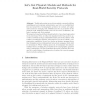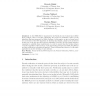19 search results - page 2 / 4 » Inductive methods and contract-signing protocols |
AAIP
2009
13 years 6 months ago
2009
The development of software engineering has had a great deal of benefits for the development of software. Along with it came a whole new paradigm of the way software is designed a...
TPHOL
2009
IEEE
13 years 12 months ago
2009
IEEE
Traditional security protocols are mainly concerned with key establishment and principal authentication and rely on predistributed keys and properties of cryptographic operators. I...
JUCS
2007
13 years 5 months ago
2007
: In the IEEE 802.1D standard for the Media Access Control layer (MAC layer) bridges, there is an STP (Spanning Tree Protocol) definition, based on the algorithm that was proposed...
FORMATS
2004
Springer
13 years 9 months ago
2004
Springer
We discuss the modeling and verification of real-time systems using the SAL model checker. A new modeling framework based on event calendars enables dense timed systems to be descr...
JCS
2010
13 years 3 months ago
2010
Protocol authentication properties are generally trace-based, meaning that authentication holds for the protocol if authentication holds for individual traces (runs of the protoco...


